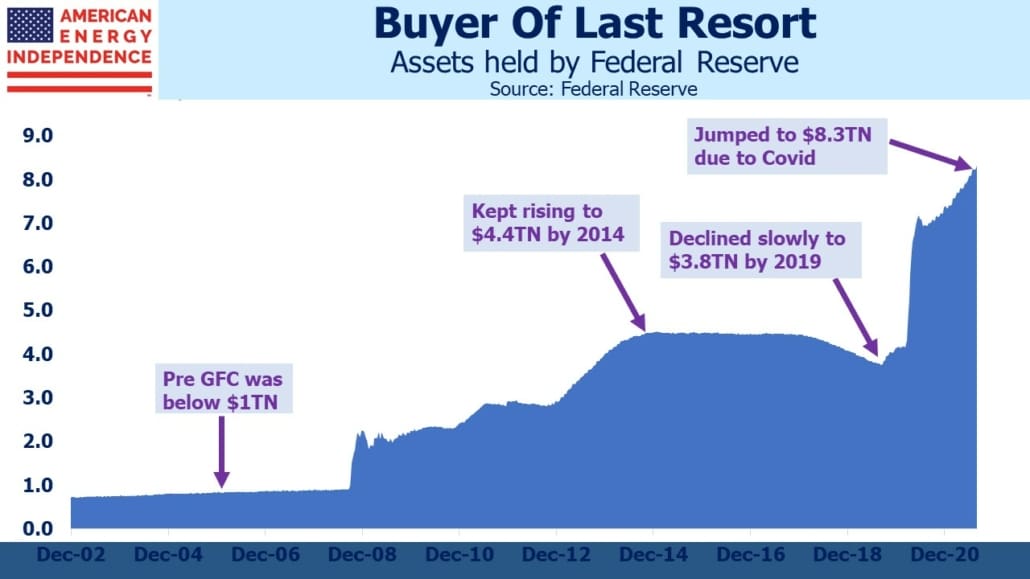The Fed’s Balance Sheet Has One Way To Go
This week the Fed is holding their annual Jackson Hole symposium – although it will be virtual again because of the Delta variant. Media coverage has built expectations of a sharp internal debate around tapering. The recent minutes show some in favor of reducing the Fed’s bond buying program this year. Boston Fed president Eric Rosengren noted the futility of using low rates to stimulate interest rate sensitive sectors such as housing when demand is already strong (listen to our recent podcast Episode 80: Tapering Draws Closer).
Since former Fed chair Ben Bernanke showed the world in 2008 that Quantitative Easing (QE) could be done safely, the Fed has been a buyer of US treasuries almost all the time. Their balance sheet only shrunk for a year beginning in May 2018 and began growing sharply again early last year in response to Covid.
Bernanke’s original initiation of QE was criticized at the time as likely to cause inflation. He was correct that it wouldn’t, recognizing that Wall Street’s frozen plumbing needed extraordinary help. Once the crisis passed the FOMC struggled to extricate itself from the bond buying program. The 2013 “taper tantrum” when bonds slumped on fears of QE ending continues to hover over today’s FOMC deliberations.
It should be clear that the need for QE is long gone – not least because this time around inflation has surged. Most obviously the $40BN per month of mortgage-backed securities purchases should cease since the housing market is hardly short of demand.
Even when tapering begins it will only slow the Fed’s balance sheet growth, since they’ll still be buying bonds albeit at a slower rate. QE is now part of the Fed’s toolkit, to be used whenever accommodative policy is needed. A decade passed since the 2008-09 Great Financial Crisis before any meaningful reduction in the Fed’s balance sheet occurred.
The Fed’s original exit strategy was to let holdings mature and not replace them. This time around their holdings will likely flatten out around $9TN, 2X the peak from the earlier crisis. It’s hard to imagine the Fed moving to actually sell bonds, so allowing the portfolio to run off remains the most likely outcome, as before.
It’s a good bet that the next crisis will hit before any meaningful reduction in this $9TN balance sheet. The bar has been lowered. QE is being justified in part to promote job creation, part of the Fed’s twin mandate of achieving full employment with stable prices. If a bear market in bonds threatened the economy, it’s likely the Fed would see fit to step in and assure an orderly market. If our foreign creditors sold US treasuries, either for geopolitical reasons or out of frustration with our profligate fiscal policy, the Fed would scoop those up too.
The Fed is now and probably always will be the biggest buyer of US government debt. Their $8.3TN balance sheet includes $5.3TN of US treasuries, almost a quarter of all publicly held US debt. The Fed’s now permanent holding of US treasuries is debt monetization. Only three quarters of the government’s borrowing is being met by a combination of domestic and foreign savings. QE was originally intended as a temporary measure in extraordinary times, but it’s become business as usual. The Fed is enabling The Magic Money Tree (see Modern Monetary Theory Goes Mainstream).
Rep. Alexandria Ocasio-Cortez, a fan of government solutions for everything, said in 2019 that MMT needed to be, “a larger part of our conversation.” AOC and her progressive wing of the Democrats are not on the side of investors.
Our fiscal path virtually guarantees continued growth in the Fed’s balance sheet. Publicly held debt:GDP crossed 100% because of Covid and is on track to double over the next thirty years. This is based on figures from the non-partisan Congressional Budget Office, which doesn’t assume recent uber-profligacy will become endemic. It’s hard to see how The Fed will reduce its holdings when the CBO expects debt to increase annually at $1TN or more for the next thirty years.
This is why inflation is inevitable. QE has morphed into debt monetization, enabling ever larger deficits even while our fiscal outlook is poised to soar beyond past extremes. Bonds have been emasculated of their ability to warn of such excess, because the Fed stands ready to provide support whenever needed.
It’s never been more important to invest with regard to maintaining purchasing power – which means staying well ahead of inflation (see Why It’s No Longer Enough To Beat Inflation).
We are invested in all the components of the American Energy Independence Index via the ETF that seeks to track its performance.
We have three funds that seek to profit from this environment:

